Written and photographed by: Natasha Tar
Welcome to yet another SFU art walk! After reading the other two that The Peak wrote up, I’m sure you folks are all ready for another one. Art is as rampant as the common cold on our campuses, and it’s about time we gave it a nod and some undergraduate-student analysis. This time around, we will be looking at five pieces, including one that has literal chunks of rose quartz embedded in it.
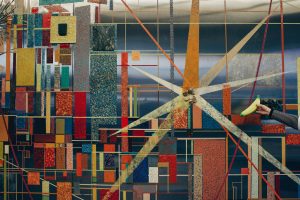
Theatres of the World by Buell Mullen
Where? In the Leslie & Gordon Diamond Family Auditorium at Burnaby campus
When? Given as a gift from the International Nickel Company of Canada Ltd. in 1965
Sometimes I like to think people steal the koi in the reflecting pond and sell/eat them. I mean, c’mon, if SFU gives out free stuff, you take it, right? So when I saw the bright murals that are Theatres of the World for the first time, my fingers were itching to cross the defenseless velvet rope that separated me from the piece and yank off a chunk of precious mineral.
Buell Mullen’s two murals look like intricate and abstract world maps, though SFU Galleries’ public art guide states that the inlaid rocks, such as quartz and gold, were all unearthed from within the vicinity of the school.
The Chicago artist has done similar steel murals for other places, and some publications such as Arts Education Policy Review comment that her work has a hardiness that will easily allow it to outlast canvases. This may be another reason that SFU embraced this piece; the murals’ tough nature suggest that the university and its impact will also last a long time. The stainless steel pieces were also built specifically for the auditorium.
Theatres of the World, to me, symbolizes connecting the world together in the lecture halls of SFU. After over 50 years, this has happened to an extent, but we’re still working on the “friendliness” part of being together.
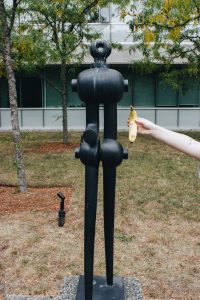
Steptease by Sorel Etrog
Where? At Saywell Courtyard at Burnaby campus
When? Created in 1976, given as a gift in 2009 by the artist
Steptease is one of three strange-looking statues that grace the Saywell Courtyard. When I first wandered up to these things, I definitely thought their names were sexually suggestive. Steptease can easily be misread as “striptease,” and Ritual Head . . . well . . . I’m sure you can make what you will of that one. (Can you see the two hand-like objects grasping a long rod?)
Sorel Etrog is a Romanian-Canadian who started his artistic studies in Israel. SFU Galleries explain that “his forms register as levers, hinges, and blades, but also resonate as limbs and lobes . . .” After reading this, I realized that these sculptures make sense on a university campus because students are definitely part-machine. At least, schools work us as if that were the case.
I would say that Steptease doesn’t really evoke teasing for me. There’s definitely a compass (the math kind, not the “I’m lost, help” kind) and a human body in the statue’s shape, but it’s taking a very non-sexy step. Perhaps Etrog meant to tease us with an inhuman sculpture that our minds interpret to have a curvy, female form. Either way, and despite being covered in bird crap, these statues make for a nice visit on rare sunny days.
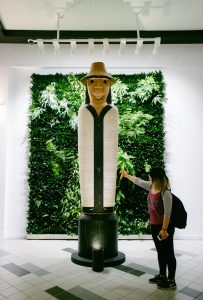
Sey̓em̓ (Musqueam Welcome Figure) by Brent Sparrow
Where? In the lobby at Vancouver campus
When? Created in September 2017
It’s always enjoyable to walk into a building and immediately be greeted by art. This figure is especially remarkable because it was built specifically for welcoming, and it reminds people of the traditional land they live and work on. Sey̓em̓ was carved from a Vancouver Island cedar log by Musqueam artist Brent Sparrow. According to the informational plaque beside the piece, sey̓em̓ means “noble, influential, and wealthy members of the community.” The plaque also explains that the figure is wearing the clothes of a noble, such as a wool blanket and a woven red cedar hat.
For me, Sey̓em̓ definitely gives off a powerful vibe. It stands out boldly from the living wall installed behind it, and there are bright lights shining on its tall figure. It’s impossible to miss if you are entering the campus, and I believe that having an immediate Indigenous presence in a university, or anywhere really, is an important step towards acknowledgement and reconciliation.
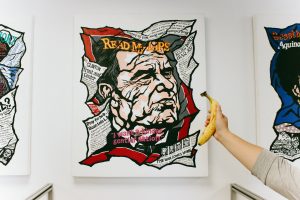
Heads of State by Gu Xiong
Where? In the quiet study space of Belzberg Library at Vancouver campus
When? Created in 1992, given as a gift from Russell Precious in 1995
The Belzberg Library at the SFU Vancouver campus is pretty unassuming, until you walk into the quiet study area on the second floor. There, you will find a variety of infamous political figures staring at you from the walls, such as George Bush, Saddam Hussein, and Fidel Castro. The acrylic paintings by Canadian-Chinese artist Gu Xiong feature political figures on crumpled magazines, usually with one of their famous quotes and a few news articles. I’m not a political person, but these paintings immediately struck me.
My favourite is the one of Bush, with his famous quote, “I want a kinder, gentler nation,” alongside article scraps from his presidency that mention war and bombings. This piece, like the others, features Bush as crumpled, but not completely torn up. Could the crumpling be a result of him, a powerful person and icon, being discarded? Or was he crumpled, thrown away, but somehow found and uncrumpled? There are multiple meanings you can draw from these pieces, which is part of what makes them great and fun to look at.
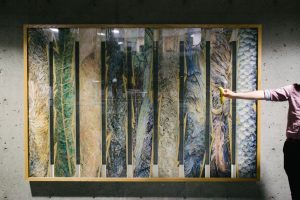
Skins by Gloria Massé
Where? In Maggie Benston Centre at Burnaby campus
When? Created in 1989, given as an unspecified donation
Hailing from Gibsons, B.C., Gloria Massé’s art focuses on one of her greatest loves: nature. Most of her art also has a strong focus on texture, and Skins is no exception. The name reflects the simple images the painting provides: the skins of different things is nature. The “skins” are separated into individual boards.
When you hear “skin,” the first thing that comes to mind is probably human skin. However, Massé’s piece does not feature human skin, but rather the “skins” of nature we don’t think as much about. Some of the skins I can recognize right away are fish scales, feathers, and leaves. The others are a bit more ambiguous, but one can interpret a bug’s wing or bark depending on how they look at it.
The piece might be reminding us of our close ties to nature, or that we should try to reflect more on nature because we all share this world together. Skins is also a beautiful examination of texture which contrasts nicely with the plain cement walls of MBC.





